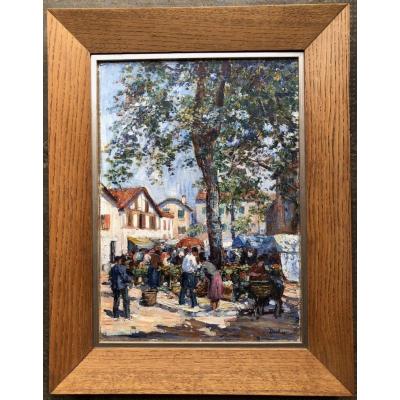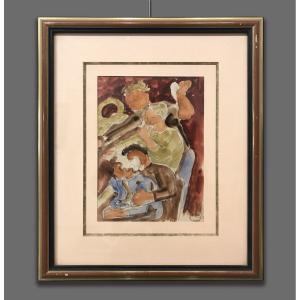Dressing a knight before the battle
Oil on slate, cm 48 x 47
With frame, cm 60 x 58
Signed in the lower right FM
The enigmatic episode depicted, which presents two knights preparing for the battle that is uneasy behind them, opens up to multiple interpretations. In the foreground a group of three knights are waiting to enter into action: the first puts the sword in the hilt, side by side, the other raises the sky with a studded mallet, both are dressed in an old fashioned armor that recalls the Roman world. A third knight, this time dressed in contemporary fashion, is helped by two attendants while wearing the imposing suit with feathered hat.
Figures of knights are not unusual in the catalogue of Cecco Bravo, painter of the seventeenth century Florence, known for his original style and for a personality as fascinating as enigmatic.
See in comparison works such as Angelica and Ruggero of the Smart Museum of Art, Chicago, the Erminia and the shepherds of the Civic Museums of Pistoia or the Angelica and Ruggero of the Pretorio Palace of Prato.
But it is above all the brushstroke, loose and characteristic effusa painting, built on brushstrokes of discontinuous color, on contrasts between transparencies and blows of more substantial matter, between flashes and effects of backlight, that characterizes this work, Thus connecting it to the art of Montelatici.
With a bizarre spirit, Cecco Bravo also came close to the artistic environment of Veneto, in particular painters such as Sebastiano Mazzoni and Domenico Fetti. The painter’s independent activity is recorded since 1624, as can be seen from some quotations of the court of the Academy of Design, in which he begins to be mentioned as Cecco Bravo. He became an academician in 1637 and remained a member of the institution until 1659, shortly before his departure for Innsbruck to the court of Archduke Ferdinand Charles of Austria and Anna de' Medici, counts of Tyrol. Among his most famous works are the frescoes on the northern wall in the Salone degli Argenti, on the ground floor of Palazzo Pitti. The frescoes, made on the occasion of the marriage between Ferdinando II de' Medici and Vittoria della Rovere, were completed between 1638-1639 and depict Lorenzo il Magnifico brings peace and Lorenzo il Magnifico welcomes Apollo and the Muses. They demonstrate a painting with fluid and transparent chromaticity derived from Pietro da Cortona, who had recently completed the frescoes in the room of the Stufa at Pitti. After 1650, Montelatici’s painting was oriented towards a greater formal restlessness, dominated by dark tones, aimed at the dematerialization of space, defined rather by increasingly nuanced brushstrokes in correspondence with the background. In this particular case the materiality of the brush strokes is accentuated even more thanks to the particular support, the slate, which absorbs little or nothing the oil painting and leaves the colors very bright and vibrant. The choice of this stone as support is explained by its conservation capacity and the particular pictorial rendering, Not for nothing great artists like Titian and Sebastiano del Piombo used it but there are many painters of the past who used this stone, especially in the sixteenth and seventeenth centuries.










































 Le Magazine de PROANTIC
Le Magazine de PROANTIC TRÉSORS Magazine
TRÉSORS Magazine Rivista Artiquariato
Rivista Artiquariato